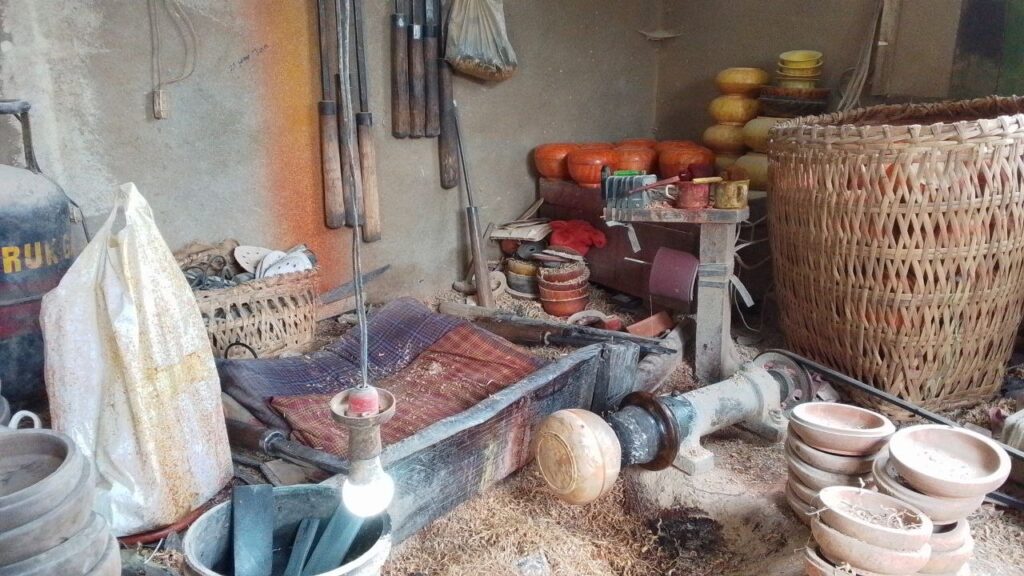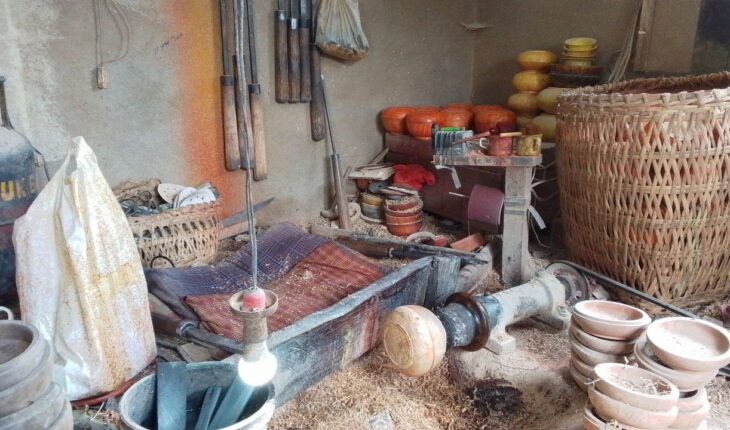
A story of resilience of Dapa artisans in Trashiyangtse who not only thrive but carve a living off it
KINZANG DORJI TSHERING
Thimphu
In the far-eastern district of Trashiyangtse, surrounded by pristine forests and steeped in cultural heritage, the craft of Dapa-making continues to thrive against the odds. These handcrafted wooden bowls, known locally as Dapas, have been part of Bhutanese tradition for generations.
Despite the growing reach of modernization, this practice remains deeply rooted in the lives of a few determined artisans who continue to preserve it—not just as a source of livelihood, but as a living legacy.
Among these artisans is Tenzin Namgyal, a skilled wood-turner who has been practicing the craft for many years. For Tenzin, Dapa-making is more than a job—it is a sacred inheritance, passed down through generations of craftsmen in his family.
“My forefathers used to make Dapas, and now the responsibility have been passed on to me,” he shared. “It’s more than just work; it’s a legacy I hold very dear.”
Despite the advances in tools and technology, Tenzin continues to rely on many of the same traditional instruments used by his ancestors. However, one change has significantly improved the efficiency of the process—the introduction of electric motors.
“We still use the same tools that were used back in the day,” he said. “In the past, there were no motors, so we had to operate the lathe using our legs. Nowadays, we use motors, which make the work faster and less tiring. But aside from that, all the other tools are from when the craft originally started.”
This blend of traditional craftsmanship and modest modernization reflects Bhutan’s unique path to development—where old practices are not discarded, but rather adapted to suit the times.
In Tenzin’s small workshop, this coexistence is visible: the electric motor hums steadily while his hands skilfully guide the tools shaped and sharpened by his predecessors.
Tenzin’s production capacity is a testament to his experience. On an average day, he can make between 13 to 14 standard-sized Dapas. When working on smaller varieties called Gogpor, he manages to produce up to 20 pieces in a day. For larger bowls known as Tsamdar, the number falls to around 10, owing to the time and effort required for each.
“It all depends on experience,” he explained. “Someone new to the craft would take much longer to produce the same number of pieces.”
Dapa-making is a seasonal activity in many parts of eastern Bhutan, particularly thriving during the winter months when agricultural activities slow down. Yet, the income generated through this craft is not fixed. Instead, it fluctuates based on the availability and cost of raw materials.
“Our income depends mostly on how much raw material we’re able to purchase,” said Tenzin. “The more raw materials we have, the more we can produce—and that means more income. But when there’s a shortage, production drops, and so does our revenue.”
Wood such as maple and rhododendron is commonly used to make Dapas, and artisans must source it carefully to maintain quality. Sometimes, supply chains stretch as far as neighboring countries like Nepal, from where additional materials are brought in. This indirect cross-border trade has quietly helped sustain the industry in Trashiyangtse.
“We also get a lot of materials from Nepal that help us indirectly in the trade part of our country,” Tenzin noted.
Beyond monetary gain, Dapa-making carries social and cultural weight in communities like Tenzin’s. The income supports families, helps pay for children’s education, and contributes to the preservation of intangible heritage.
“It helps us put our children in school, raise our families, and also provides a couple of job opportunities,” he said. In a region where employment opportunities are limited, the craft has offered many a dignified means of survival.
Yet, despite its value, the craft is slowly fading in the eyes of the youth. Tenzin expressed concern over the waning interest among younger generations.
“Even though the tradition is still alive, I don’t often see youth getting involved in it,” he said. “The main reason is that you’re not able to generate a good amount of profit unless you give it your all. But there will always be a profit if you are giving it your all and you have plenty of raw materials.”
This sentiment reflects a broader challenge across Bhutan, where traditional arts struggle to compete with the allure of urban jobs, overseas employment, and modern lifestyles.
“The youth of our country hardly take any interest in this,” Tenzin added. “There are only a few people in their late 40s and 50s who want to learn about this craft.”
For a tradition so rich in identity and skill, this trend is disheartening. Many artisans like Tenzin believe that with better support—such as easier access to raw materials, training centers, and market linkages—more youth might consider joining the trade.
Government agencies like the Agency for Promotion of Indigenous Crafts (APIC) and local cooperatives like Shagzo Tshogpa have made efforts to promote Dapas through festivals, training programs, and cooperative marketing centers. However, artisans still face hurdles in scaling their work or ensuring sustainability.
The evolution of Dapa-making also tells a story of Bhutan’s larger journey. Once entirely handmade with muscle-powered lathes, the craft now accommodates small motors, sandpaper, and other practical innovations.
“Back in those days, we didn’t have proper tools to make Dapas, and it was all handmade,” Tenzin recalled. “Now, access to motors and sandpaper, which are essential, has completely changed how we work. This shows that our country is growing.”
The balance between preserving tradition and embracing change is delicate but necessary. For craftsmen like Tenzin, the key lies in adaptation without erasure. His bowls—smooth, symmetrical, and subtly fragrant with the scent of polished wood—tell stories not only of utility but of endurance.
Today, as the wheels of his lathe spin and chips of wood scatter across the floor, Tenzin works with quiet purpose. His hands move with the rhythm of memory and skill; shaping not just wood but also hope—hope that the younger generation might one day return to this noble craft, not out of necessity, but out of pride.
“There will always be a profit if you’re giving it your all,” he said with conviction. “And more than that, there’s something priceless about continuing what your ancestors started.”
In Trashiyangtse, far from the lights of Thimphu and the distractions of the digital world, such pride still turns—steady, circular, and alive.





